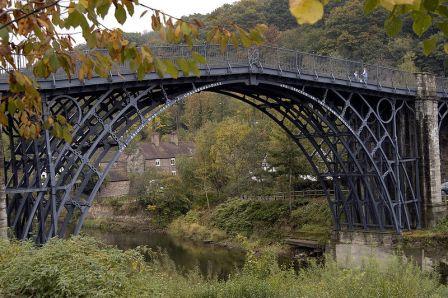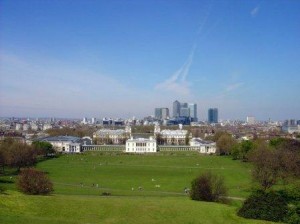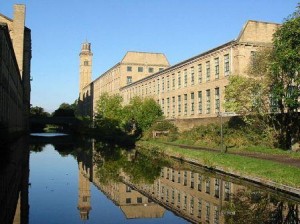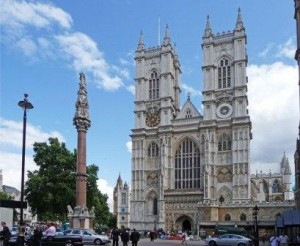
The Iron Bridge in Shropshire
The Ironbridge Gorge is an established World Heritage Site and has been described as the birthplace of the Industrial Revolution in the 18th Century and is among the most famous symbols of this period in time. Located in the English county of Shropshire close to the England and Wales border the site has been a World Heritage Site (WHS) since 1986. The area that includes the town of Ironbridge, the Iron Bridge and ten museums to explore showcasing the important developments that took place here.
Overview
The Ironbridge Gorge is an internationally famous symbol of the Industrial Revolution in the UK in the 18th Century. Given that the Industrial Revolution had such far reaching effects across the UK and the world the site here has been designated as a WHS in recognition of the unique contribution made here. The area is thought to have been among the most technologically advances areas in the world by the end of the 18th century.
The natural environment that includes the gorge itself, monuments, museums and the famous Iron Bridge all have left a lasting legacy that can be seen and experienced by visitors to this day. Given the special and unique importance of the elements present here visitors can see and experience for themselves the universal importance of the area.
The Gorge itself formed by the river Severn in Shropshire, it was formally known as the Severn Gorge, however the name has since changed to include the Iron Bridge, that in itself was the first iron bridge of its type in the world and seen as a great piece of engineering. The bridge was built back in 1779 to link together local towns including Broseley and Coalbrookdale.
The site contained raw materials such as coal, iron, ore and clay and can be easily accessed in the gorge and the river allowed good transportation of these products, hence the areas early importance. The gorge itself was formed during the ice age.
The Ironbridge World Heritage Site consists of an area over 5 km2 and includes areas of the Severn Valley from Ironbridge to include other valleys towards Coalbrookdale and Madeley.
The Iron Bridge is a favourite place to visit for tourists to the area. It is built over the River Severn, the bridge has become an iconic symbol of the area and the Industrial Revolution, the bridge has had a wide ranging impact on the local area and economy along with influence in design of bridges and materials used in bridges much further a field. The bridge has been subject to conservation and restoration work to ensure it is maintained.
The Gorge highlights some of the remains of the period of time it is most associated with, there are still remains of factories, mines, ironmasters, local transport, housing and the local landscape as evidence of influential past of the area. There are also plenty of archives and artefacts that further indicate the importance of the area during a time of great innovation and development.
Currently the site is part of a working community where the past has been preserved and made accessible to visitors by organisations responsible for the conservation and preservation of the history and culture of the area.
There are 10 museums located along the banks of the River Severn for visitors to explore further. The museums pay tribute to and explain past history here. The places of interest for visitors include:
The Blists Hill Victorian Town, here visitors will step back in time to a Victorian era and see people live as people did at that time. A visit here gives visitors a better sense of the history and culture of the local area and the time period.
Enginuity, is a museum that contains a fine collection of art castings along with providing visitors with further information the range of skills used by craftsman of the day and the wide versatility of Iron.
Darby Houses, provide visitors with an insight in to the lives of the Darby family along with reading extracts from family papers and learning more about their business and family lives. The Darby family managed the Coalbrookdale ironworks for five generations.
The Museum of the Gorge, is located on the banks of the River Severn and represents the place from which goods were once sent to the rest of the world. Built originally as a warehouse the gothic style building, it was used to store iron products that were produced by the Coalbrookdale company.
Coalport China Museum, contains national collections of Caughley and Coalport china. There are rich colours, glazes and decoration on display here. Visitors can see the demonstrations of traditional ceramic techniques showing more on production of ceramics.
Tar Tunnel, here visitors can walk approx 100 yards in to the tunnel and see the tar that is still visible. The natural bitumen was discovered here that formed from plants and animals, the bitumen was collected in wells and boiled in to convert it into pitch to be used for the preservation of timber. Some of the tar was used in lamps whilst others were used in British Oil used for the treatment of rheumatic and skin problems.
Jackfield Tile Museum, is located in the Craven Dunnill Factory. The museum shows the decorative tiles that were used extensively during the days of the Empire. Visitors can see workshops, classic galleries and a fully operational tile manufacturing and restoration business. It was once at the centre of the tile industry worldwide.
Broseley Pipeworks is famous for the clay pipes it used to export worldwide. The factory ceased production in the 1950s and has been preserved to give visitors a real sense of what the factory was like in its heyday.
The Iron Bridge Tollhouse, is likely to have been built prior to the bridge being was opened to traffic. The tollhouse was made bigger in 1835 taking it to the size it is currently. Toll prices here required payment even from Royalty.
Visitors to the museums, Iron Bridge and the town of Ironbridge can get a real sense of what life was like in the area, with the well maintained and preserved buildings, archives, artefacts and displays offering visitors the chance to learn and appreciate much more about the area.
How To Get There
The town of Ironbridge in Shropshire is approx 3 hours drive from London, one hour from Manchester and around 45 minutes from Birmingham in the Midlands.
By Car:
The county of Shropshire is connected to the M6 Motorway via the M54. Take the M54 until junction 4. Take the A464 and at the second roundabout turn left on to the A442 and then take the A4169. From Junction 4 of the M54 there are Brown signs directing you to the area.
For those visiting the Iron Bridge, the Museum of the Gorge and Tollhouse, there are pay and display car parks available to use in close proximity. For those visiting other museum sites, there is car parking is available also.
By Train:
The closest train stations are located at Telford, approx 5 miles from the site.
By Bus/Coach:
National Express offer coaches from a range of locations across the UK to Shropshire, the closest station is at Telford.
The Gorge Connect shuttle bus operating from March to October on Weekends and Bank Holiday Mondays, offers a good way to see the area and attractions by public transport. The shuttle bus allows visitors to see the museums, gorge and attractions.
The Gorge Connect services a number of locations including:
Coalbrookdale Museum of Iron, Enginuity, Museum of the Gorge, The Iron Bridge, Legges Way car park, Coalport China Museum and Telford Town Centre bus station.
Contact Details
Address:
The Ironbridge Gorge Museum Trust
Coach Road
Coalbrookdale
Shropshire TF8 7DQ
Telephone: +44 (0)1952 435 900
Fax: +44 (0)1952 435 999
Website: Ironbridge Museums & Gorge
Facilities and Information
Facilities:
Apart from the iconic Iron Bridge, there are 10 museums and the town of Ironbridge to explore. There are cafes and restaurants for drinks, snacks and meals in Ironbridge Town
It is recommended visitors check all opening and closing times and specific days they plan to visit any of the attractions in the area, to get the latest information & avoid disappointment, as changes can occur.
Opening Times:
Blists Hill Victorian Town:
Open 10.00 to 16.00 (7 days a week)
Enginuity:
Open 10.00 to 17.00 (7 days a week)
Coalbrookdale Museum of Iron:
Open 10.00 to 17.00 (7 days a week)
Darby Houses:
Open 10.00 to 17.00 (7 days a week) Closed During the winter.
Jackfield Tile Museum:
Open 10.00 to 17.00 (7 days a week)
Coalport China Museum:
Open 10.00 to 17.00 (7 days a week)
Museum of The Gorge:
Open 10.00 to 17.00 (7 days a week)
The Iron Bridge & Tollhouse:
Open 10.00 to 17.00 (7 days a week)
Broseley Pipeworks:
Open 13.00 to 17.00 (7 days a week) from Late May to Late Sept & Closed in Winter.
Tar Tunnel:
Open 10.00 to 17.00 (7 days a week) from April to October only. Closed in the winter.
Further Information:
Ticket prices vary from free to visit the Iron Bridge & Tollhouse to approx £11 to visit Blists Hill Victorian Town. Using a Passport Ticket can help to lower the cost of tickets to see the attractions. The passport ticket provides access to all 10 Museums. The cost is approx:
£15 for Adults & £10 for Children & £48 for Family Tickets
Tickets can be purchased at the Visitor Information Centre in Ironbridge or in advance by telephone.
Map
View Larger Map
For Local Search and Directions see: Ironbridge Gorge Map
Tips & Other Considerations
There may be some variations on the opening hours depending on the time of year and other factors. Visitors are advised to double check before going to ensure any attractions and place of interest is open and avoid disappointment.
When travelling always remain alert and aware of your belongings at all times especially your wallet/purse and valuables and ensure they are hidden away from public view (particularly at tourist attractions & places with crowds). If you have a bag try to use a shoulder bag with a good quality, strong strap, that is put across your shoulder not on your shoulder making it more difficult for anyone to take your bag.
If you are travelling by car to the town of Ironbridge and the WHS area ensure you are well prepared with maps and Sat Nav to aid your journey, particularly if you are not familiar with the local area and roads. Use the journey & route planner for useful door to door directions for car journeys and public transport.
If you are looking for local car parking, ensure you fully understand the rules, regulations & charges for car parks and street parking. The parking rules can be complex if you are not sure it is wise not to park there.
If you are travelling by public transport, it is useful to check for service updates prior to beginning your journey for any delays, disruption or cancellations to services that may impact on your journey. Ensure you have the service timetables for the trains, trams, buses and coaches. Remember when the last services are and ensure you make it to the train/bus/coach stops well in time to avoid missing the service.
Disclaimer: The information given in on this website is given in good faith and to the best of our knowledge. If there are any discrepancies in no way do we intend to mislead. Important travel details and arrangements should be confirmed and verified with the relevant authorities.




